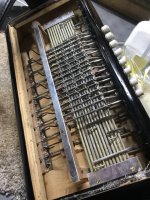Bontiki
Newbie
hello there,
the chord buttons on this 24 bass box felt stiff and rough when pushed and on inspection the metal parts look corroded.
Ive searched couple posts and sanding the bits that move other bits connected to the pallets seems to be the way forward? maybe? should I clean and sand all parts that look corroded ? the rods with buttons on the end that slide thru the wooden slots rise up a bit and rub against the underside on the aluminum strip. I was thinking that the spring tension may contribute to why its stiff ? I'll service the pallets and could replace ,or if there's a way to, adjust the springs . I have a Couple of 60's Hohner Boxs and both have easier actions than this 50's Serenelli . I realise its a cheap italian box and I could be over thinking things .
any info greatly appreciated .
Cheers
Roy
the chord buttons on this 24 bass box felt stiff and rough when pushed and on inspection the metal parts look corroded.
Ive searched couple posts and sanding the bits that move other bits connected to the pallets seems to be the way forward? maybe? should I clean and sand all parts that look corroded ? the rods with buttons on the end that slide thru the wooden slots rise up a bit and rub against the underside on the aluminum strip. I was thinking that the spring tension may contribute to why its stiff ? I'll service the pallets and could replace ,or if there's a way to, adjust the springs . I have a Couple of 60's Hohner Boxs and both have easier actions than this 50's Serenelli . I realise its a cheap italian box and I could be over thinking things .
any info greatly appreciated .
Cheers
Roy

